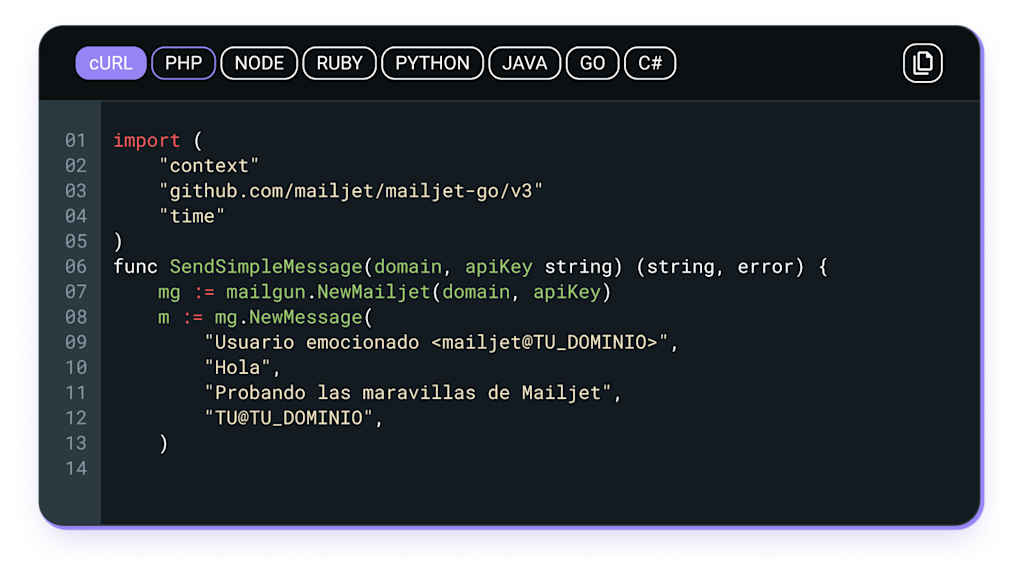Solución completa de API de Email para desarrolladores
Aunque todos los negocios necesitan una plataforma de email que envíe sus mensajes transaccionales y de marketing, no todas las empresas requieren las funciones de marketing que aporta Mailjet. Para estos casos, hemos diseñado una solución de email a escala centrada en los aspectos más técnicos: la API Mailjet.
Integra la API de Mailjet en minutos
Integra Mailjet en un tiempo récord y empieza a programar, enviar y hacer el seguimiento de tus emails mediante retransmisión SMTP o nuestra API de envío. Utiliza nuestras bibliotecas listas para usar en tu lenguaje preferido: PHP, Ruby, Python, C#, Java y muchos más. Tienes toda la información necesaria en la documentación de la API de Mailjet.


Llega a la bandeja de entrada
Aunque la rapidez es vital en el envío de emails, es igual de importante garantizar que llegan a su destino. Accede a nuestros equipos de servicios de entregabilidad, que te ayudarán a optimizar esta faceta mediante la configuración de IP dedicadas, la mejora de tu reputación de remitente y otras muchas técnicas.
Personaliza tus emails
Personaliza tus emails con Handlebars 3.0 o Golang. Usa cualquier lenguaje para incluir tokens de personalización en tus plantillas de email y crear contenido totalmente personalizable y editable para toda tu lista de contactos. Y si estás buscando un editor de email sencillo, puedes recurrir al sistema de diseño de arrastrar y soltar de Mailjet, Editor de Emails, para crear emails con imágenes dinámicas, elementos para hacer clic y mucho más. Tienes incluso la posibilidad de colaborar con tu equipo en tiempo real, lo que te ahorrará tiempo.


Confía en la fiabilidad de nuestra infraestructura
Nuestra infraestructura es muy fácil de usar gracias a nuestra sencilla integración SMTP y a las API de transferencia de estado representacional RESTful. Puedes adaptar el volumen rápidamente —desde 10 emails a 10 millones, o a los que quieras— y despedirte de las complicaciones del envío de email a gran escala. Tanto Mailjet garantizan una disponibilidad del 99,9 % del tiempo gracias a la fiabilidad de nuestras infraestructuras y herramientas.
Entérate al instante de cualquier problema de entrega
Serás la primera persona en enterarse de cualquier contratiempo que se haya producido con tus emails gracias a la función de Logs de Mailjet. Con Logs, puedes detectar y solucionar de un modo rápido y sencillo los problemas que puedan surgir con tus mensajes. Así, mantendrás en perfecto estado tu programa de email y tu reputación de remitente.

Gestiona el tráfico entrante
Procesa los emails entrantes con el software de análisis de email de Mailjet para sincronizar a la perfección los datos de tus emails con otras herramientas o sistemas. Mailjet convierte tus emails en datos estructurados y elimina las partes innecesarias —como los bloques de firma y las respuestas citadas— para facilitar la lectura. Si ya estás usando Mailjet o estás explorando las posibilidades de la Parse API de Mailjet, no te preocupes, siguen en activo. La documentación de la Parse API de Mailjet te ayudará a dar los primeros pasos.


Disfruta del apoyo de nuestros equipos de soporte
Nuestro equipo de especialistas en API entenderá tus necesidades técnicas a la primera y te ayudará a identificar el origen de cualquier problema que puedas encontrarte. Te apoyarán para mantener tu sistema estable, aumentar la entregabilidad y garantizar el éxito a largo plazo de tu programa de email.
Ahorra tiempo con nuestras herramientas de colaboración
Aunque la API Mailjet es la solución perfecta para trabajos de desarrollo, tu equipo de marketing necesita un espacio sencillo e intuitivo para dar rienda suelta a su creatividad. Con el editor Editor de Emails de Mailjet, las personas dedicadas al diseño y al desarrollo pueden colaborar en tiempo real. Como no hace falta programar los emails desde cero en HTML, el equipo de diseño puede crear plantillas responsive sin ayuda y tú sólo tendrás que incorporar contenido dinámico mediante variables, bucles y condiciones.



